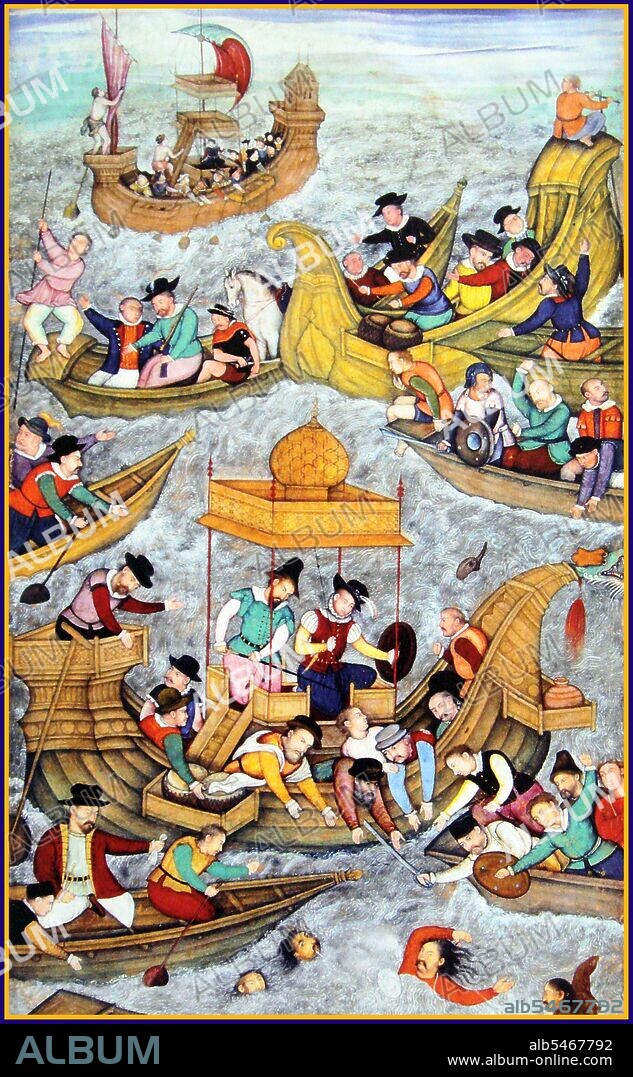alb5467792
India: The death of Sultan Bahadur at the hands of the Portuguese, Diu,1537, during the Mughal Emperor Humayun's Gujarat campaign. A scene from the Akbarnama

|
Ajouter à une autre Lightbox |
|
Ajouter à une autre Lightbox |



Avez-vous déjà un compte? S'identifier
Vous n'avez pas de compte ? S'inscrire
Acheter cette image.
Sélectionnez l'usage:

Titre:
India: The death of Sultan Bahadur at the hands of the Portuguese, Diu,1537, during the Mughal Emperor Humayun's Gujarat campaign. A scene from the Akbarnama
Légende:
Voir la traduction automatique
Nasir ud-din Muhammad Humayun (Persian: ???? ????? ???? ??????; full title: Al-Sultan al-'Azam wal Khaqan al-Mukarram, Jam-i-Sultanat-i-haqiqi wa Majazi, Sayyid al-Salatin, Abu'l Muzaffar Nasir ud-din Muhammad Humayun Padshah Ghazi, Zillu'llah; 7 March 1508 - 22 February 1556) was the second Mughal Emperor who ruled present day Afghanistan, Pakistan, and parts of northern India from 1530–1540 and again from 1555–1556. Like his father, Babur, he lost his kingdom early, but with Persian aid, he eventually regained an even larger one. On the eve of his death in 1556, the Mughal empire spanned almost one million square kilometers. He succeeded his father in India in 1530, while his half-brother Kamran Mirza, who was to become a rather bitter rival, obtained the sovereignty of Kabul and Lahore, the more northern parts of their father's empire. He originally ascended the throne at the age of 22 and was somewhat inexperienced when he came to power. Humayun lost his Indian territories to the Pashtun noble, Sher Shah Suri, and, with Persian aid, regained them 15 years later. Humayun's return from Persia, accompanied by a large retinue of Persian noblemen, signaled an important change in Mughal court culture, as the Central Asian origins of the dynasty were largely overshadowed by the influences of Persian art, architecture, language and literature. Subsequently, in a very short time, Humayun was able to expand the Empire further, leaving a substantial legacy for his son, Akbar.
Crédit:
Album / Pictures From History/Universal Images Group
Autorisations:
Modèle: Non - Propriété: Non
Questions sur les droits?
Questions sur les droits?
Taille de l'image:
3153 x 5100 px | 46.0 MB
Taille d'impression:
26.7 x 43.2 cm | 10.5 x 17.0 in (300 dpi)
Mots clés:
ART (CATÉGORIE) • ART • ART, PEINTURE • ASIE • ASIE, CONTINENT • BATEAUX • CONTINENT ASIE • EMPEREUR • EMPEREURS • GUERRE • GUERRIER • HISOIRE • HISTOIRE • INDE • INDES • INDIEN • INDIENNE • INDIENS • MARITIME • MILITAIRE • MOGHOL • MONARCHIE • NAVAL • NAVALE • PEINTURE • RECKE • ROI • ROYAUTÉ • SOUVERAIN EMPEREUR • TABLEAU • TABLEAUX • TITRE, EMPEREUR • VIE MILITAIRE ET ARMEMENT
 Pinterest
Pinterest Twitter
Twitter Facebook
Facebook Copier le lien
Copier le lien Email
Email
